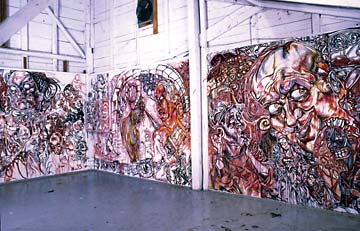
Selective Sinning: Installation view, Ink and acrylic on wall, 96" x 418"
Current Issue Highlights More Readings DA Home About Direct Art

Selective Sinning: Installation view, Ink and acrylic on
wall, 96" x 418"
So what isn’t perfect about Ali’s new approach to brush on canvas? Perhaps her flawlessly painted facial contortions strike a bit too close to home, at least for some of us. If I had—theoretically of course—viewed her paintings in a time of emotional devastation or crisis, the eerie grinning man in "Selective Sinning; Pride" would have made me cringe. The honesty of each expression is inescapable. Therein lies the beauty of young Ms. Fitzgerald’s pieces—they grip and pull at anyone willing to study their figures; they birth so much pain, ecstasy, and grace that reality aches in comparison.
Perhaps Ali has acquired an empathetic approach to art’s creation, but I doubt she’s felt all of the debilitating emotions she paints. Striking is the manner in which any experience can be extracted from Fitzgerald’s paintings. I found my own, without searching deeply; in an instant I knew the painter had to have felt these emotions—or deliberately performed—to make them appear so clearly to the spectator.
I sat down with Ali over a caramel latte, an addiction we both share, and attempted to "pick her brain" (if such a cliché could even apply to an artist so ahead of her time). We discussed the way her experience as an artist and idealist reflects in her work.
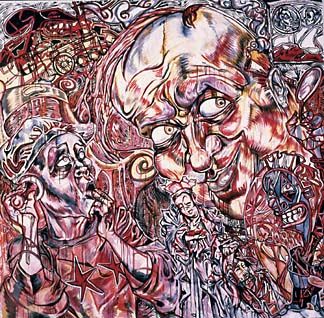 Selective Sinning: Pride, Ink and acrylic on wall, 96" x 96"
Selective Sinning: Pride, Ink and acrylic on wall, 96" x 96"
Ali Fitzgerald: I think, as an artist, I’m pretty hard to quantify, which I don’t mind. People often grapple with a label for my work, mumbling things about "Pop" or "German Expressionism." Personally, I’d say my pieces are hybrid forms that lie somewhere between painting and drawing and between Michelangelo and Mad Magazine.
AB: I’m dying to know the dirty secrets of such an openly comfortable self-analyst. What’s the inside of your studio like?
AF: Hmmm...embarrassingly enough, my studio reflects the stubborn cliché of the messy artist (there aren’t that many of us left). I really have no organizational scheme whatsoever, and my décor consists of crushed animal crackers and popcorn bags. Any number of comic books litter the floor. I do have a few Northern European Renaissance books and some old "Western Frontier" magazines. I’m a poor grad student, so I read the "fancy" art periodicals in the library rather than buy them.
AB: Your work seems to be partially informed by literature. Are there any authors you really enjoy?
AF: I love epic novels like Steinbeck’s Grapes of Wrath and Dosteovsky’s Crime and Punishment. Anything long and depressing. I’m also a big Flannery O’Connor fan; I think her short stories are incredible. I was always an avid reader, and I think this might be why my pieces are so character driven.
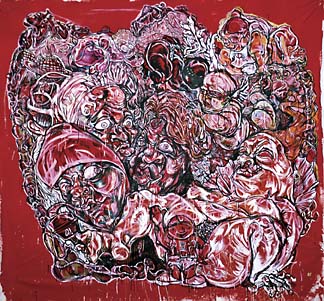 Annunciation of Bob the Builder, Ink and acrylic on canvas, 96"
x 106"
Annunciation of Bob the Builder, Ink and acrylic on canvas, 96"
x 106"
AB: Talented and intellectual? Single? No, seriously, I see some similarities between O’Connor’s work and your own: how does the grotesque figure into your art?
AF: I think that the world can be a dark place, and it would be irresponsible if no one painted it. Sublimity is hard to access, but ugliness is all around us. And I’m really exhilarated at the prospect of finding beauty in the grotesque, or comedy amid tragedy. Somehow it seems more real, or maybe just more relevant.
AB: Relevance...I think that’s what I’ve been trying to get across about your paintings and you just put your finger on it effortlessly. You’re so young that I have to ask: when did you first discover that you wanted to be an artist?
AF: As a clumsy child (one that was prone to fall skirt-up in the cafeteria), I found my bearings in art. From the moment my freakishly tiny hand held a marker, I knew I wanted to be an artist. Throughout school I drew obsessively and in the cruel throws of pre-pubescence I somehow managed to find a consistent passion in art. This all-consuming zeal for art making was rivaled only by my illogical love of shoulder pads and stonewashed "skorts."
AB: That brings me to my next question. Do you consider yourself some sort of prodigy? You’ve accomplished so much at the age of 21.
AF: I’m sorry; you must have me confused with Bobby Fischer. It’s an easy mistake, we’re both short and get lost a lot. Seriously, I hardly consider myself a prodigy. I’ve always been ambitious, but more importantly I always knew I was going to be an artist. I just didn’t see the point of taking an indirect route.
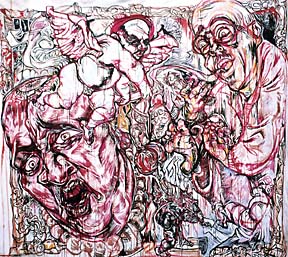 A Venusian Lobotomy
by Mr Mars, Ink and acrylic on canvas, 96" x 106"
A Venusian Lobotomy
by Mr Mars, Ink and acrylic on canvas, 96" x 106"
AB: Bold. I like it. Which artists have influenced you along the way?
AF: I’m inspired by the kinetic energy of the German Expressionists and the accessible artistic vernacular of contemporary graffiti artists. I also have giant art-crushes on Kara Walker and Nicole Eisenman. I’ve always liked work that provokes rather than placates. And truly adventurous artists always fascinate me, regardless of the media they use.
AB: Judging from your ‘Selective Sinning’ installation, it seems that you enjoy painting directly on the walls. Have you done many other wall pieces, and why does wall-painting appeal to you?
AF: Well, it’s a purer form of art, one that’s not adulterated by the commercial aspects inherent in the art business. And because the installation is only up for a short time, there is something ephemeral and honest about it. It’s more of a visual declaration than a marketing scheme. During my amazing residency at the Skowhegan School of Painting and Sculpture, I was given the freedom to paint without the pressures of a gallery or university setting. Since then, I really can’t get enough of painting on walls. There’s also an adrenaline jolt when you’re forced to make art in such a compressed time period: you have to become very good at auto-correcting. It’s thrilling really.
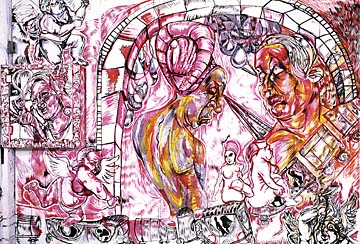
AB: What about the anachronistic elements in your paintings? What meaning does the older subject matter have for you?
AF: I’ve always been attracted to the decadence and bombast of ancient religious altarpieces. The way they saturate the viewer with visual information seems eerily parallel to our image-laden culture. We are so used to jarring images that the displaced subjects in my paintings seem appropriate and even normal. By creating these incongruities in my paintings, I feel I imbue my compositions with the same sense of exasperation and disorientation I feel every time I enter an IHOP on Sunday.
AB: I’ve never heard such eloquence in an IHOP. What about the viewer? Is his response important to you? And if so, what type of reaction do you hope to elicit?
AF: Although I want my paintings to seduce through a sense of layered visual excitement, I also want them to unsettle on some level. Gallery-goers are pretty perceptive, and tend to note the claustrophobia and chaos.
AB: What’s next? Are your paintings going to shift in any dramatic way?
AF: I’m at a fairly early stage in my artistic career, so I plan to sponge up tons of art advice at grad school, hopefully pursuing my professional career as well. I never want to become timid with my paintings, because I think it’s important to eliminate fear in order for the work to evolve. With that said, I have a pretty idiosyncratic way of looking at the world and of rendering it. While the content will inevitably vary, my paintings will probably remain stylistically consistent.
AB: Has being in Texas influenced your work at all?
AF: Being a grad student in Austin has helped my art immensely. I’ve met some really insightful faculty, and the studios are roomy enough to accommodate my giant paintings. But Austin itself is a kind of liberal oasis in the middle of Texas. Personally, I’m enthralled by the stereotypes native to Texas: the idea of the cowboy as martyr and of the saloon gal as a reinvention of Mary Magdalene. In the land of a thousand pick-up trucks, can one arrive at a healthy perception of gender? The sexual climate is really interesting here. I recently completed a painting called "The Temptation of St. Clint of Eastwood" that was informed by the vast internal landscape of Texas. Handlebar mustaches and dust balls figured prominently.
Ali FitzgeraldCurrent Issue Highlights More Readings DA Home About Direct Art